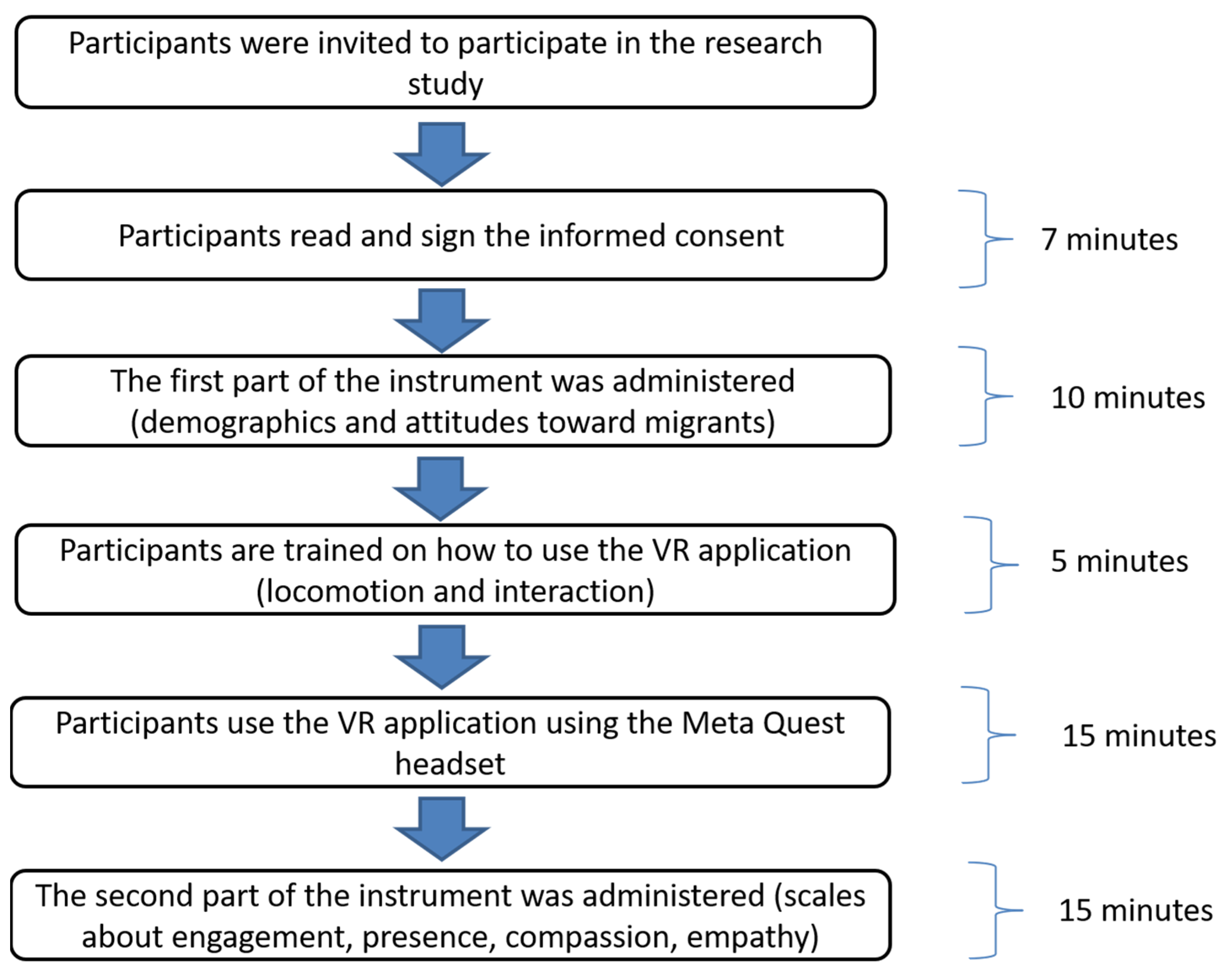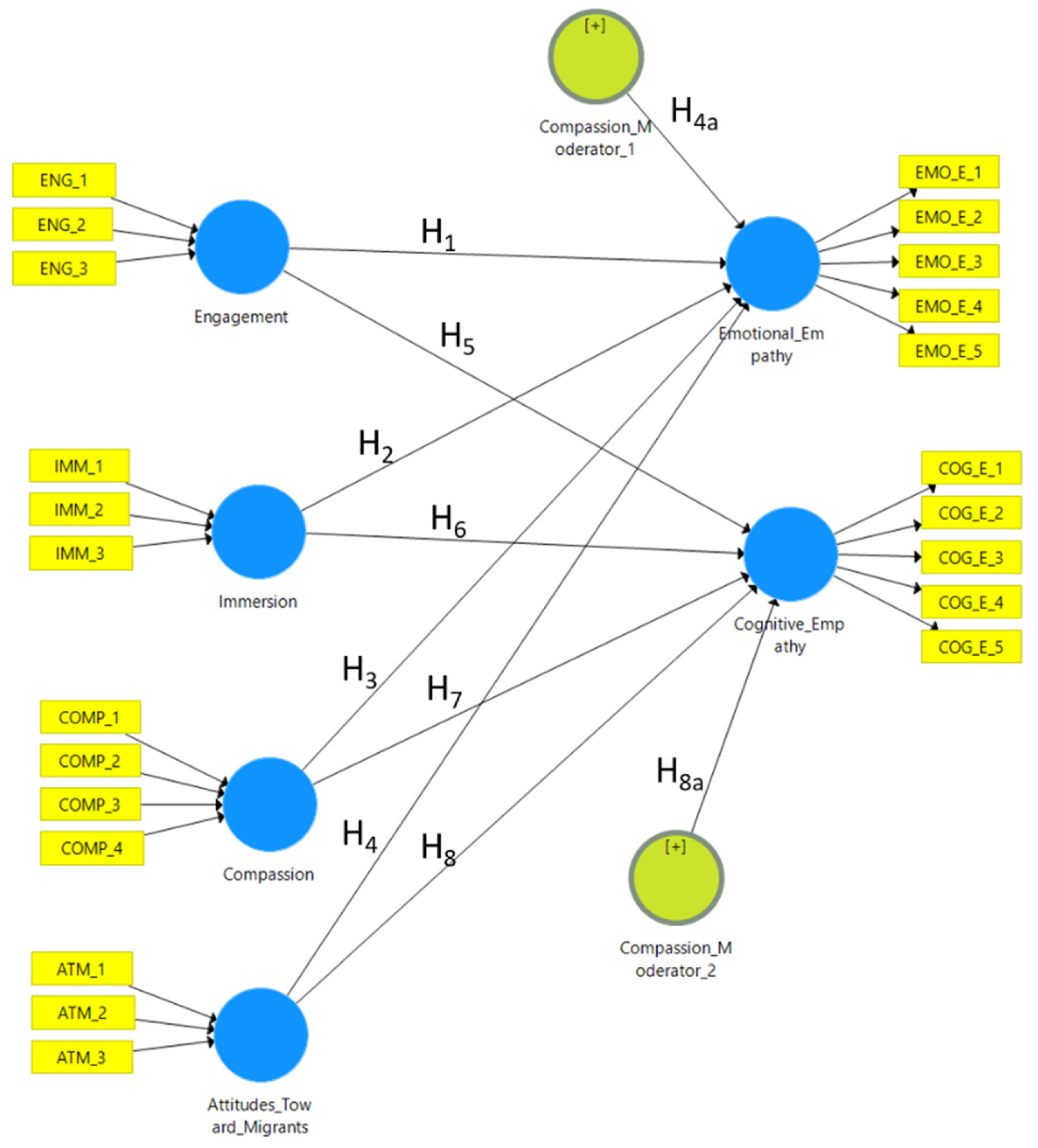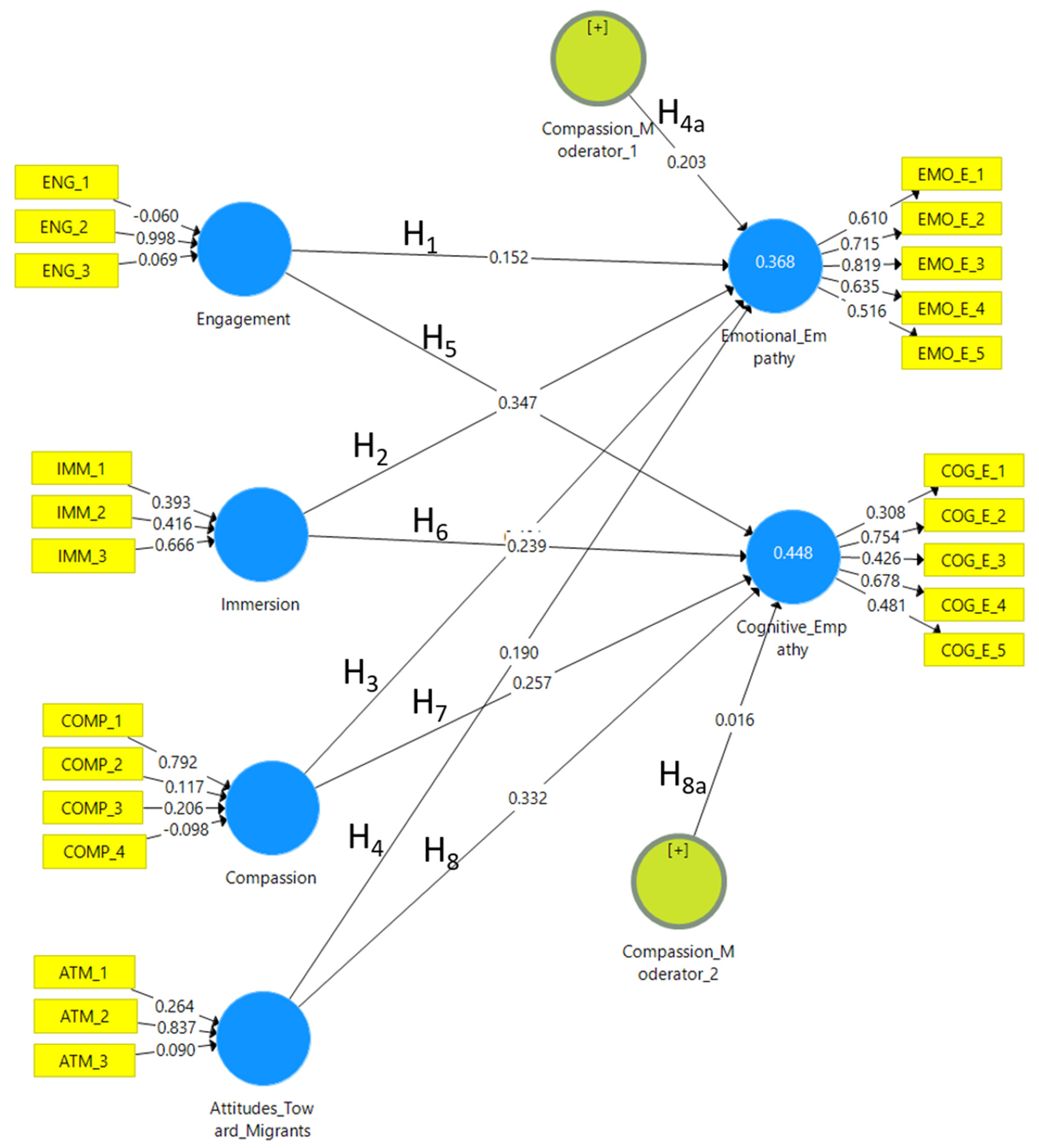Insights into the Predictors of Empathy in Virtual Reality Environments
Abstract
:1. Introduction
2. Related Work
2.1. Virtual Reality and Empathy
2.2. Virtual Reality and Migration
3. Hypothesis Development
3.1. Engagement
3.2. Immersion
3.3. Compassion
3.4. Attitudes toward Migrants
4. Methodology and Research Design
4.1. VR Environment Used to Create Empathy for Migrants
4.2. Participants
4.3. Instruments
4.4. Research Design
5. Hypothesis Testing and Results
5.1. Evaluation of the Formative Measurement Model
5.2. Evaluation of the Structural Model
5.3. Predictive Relevance of the Structural Model
6. Discussion
7. Limitations
8. Conclusions and Future Work
Author Contributions
Funding
Data Availability Statement
Acknowledgments
Conflicts of Interest
References
- Čehajić-Clancy, S. Empathy, Intergroup: Regarding the Suffering of Others. In The Encyclopedia of Peace Psychology; Christie, D., Ed.; Blackwell Publishing Ltd.: Hoboken, NJ, USA, 2011. [Google Scholar] [CrossRef]
- Stevens, L.; Woodruff, C. What Is This Feeling That I Have for Myself and for Others? Contemporary Perspectives on Empathy, Compassion, and Self-Compassion, and Their Absence. In The Neuroscience of Empathy, Compassion, and Self-Compassion; Elsevier: Amsterdam, The Netherlands, 2018; pp. 1–21. [Google Scholar] [CrossRef]
- Steuer, J. Defining Virtual Reality: Characteristics Determining Telepresence. J. Commun. 1992, 42, 73–94. [Google Scholar] [CrossRef]
- van Loon, A.; Bailenson, J.; Zaki, J.; Bostick, J.; Willer, R. Virtual Reality Perspective-Taking Increases Cognitive Empathy for Specific Others. PLoS One 2018, 13, e0202442. [Google Scholar] [CrossRef] [PubMed]
- Young, G.W.; O’Dwyer, N.; Smolic, A. Exploring Virtual Reality for Quality Immersive Empathy Building Experiences. Behav. Inf. Technol. 2022, 41, 3415–3431. [Google Scholar] [CrossRef]
- Gerry, L.; Billinghurst, M.; Broadbent, E. Empathic Skills Training in Virtual Reality: A Scoping Review. In Proceedings of the 2022 IEEE Conference on Virtual Reality and 3D User Interfaces Abstracts and Workshops (VRW), Christchurch, New Zealand, 12–16 March 2022; IEEE: Piscataway, NJ, USA; pp. 227–232. [Google Scholar] [CrossRef]
- Cohen, D.; Landau, D.; Friedman, D.; Hasler, B.; Levit-Binnun, N.; Golland, Y. Exposure to Social Suffering in Virtual Reality Boosts Compassion and Facial Synchrony. Comput. Human Behav. 2021, 122, 106781. [Google Scholar] [CrossRef]
- Lee, H.; Li, B. So Far yet so near: Exploring the Effects of Immersion, Presence, and Psychological Distance on Empathy and Prosocial Behavior. Int. J. Hum.-Comput. Stud. 2023, 176, 103042. [Google Scholar] [CrossRef]
- Cummings, J.; Tsay-Vogel, M.; Cahill, T.; Zhang, L. Effects of Immersive Storytelling on Affective, Cognitive, and Associative Empathy: The Mediating Role of Presence. New Media Soc. 2022, 24, 2003–2026. [Google Scholar] [CrossRef]
- Dennison, J. A Review of Experimental Evidence of How Communication Affects Attitudes to Immigration. Comp. Migr. Stud. 2022, 10, 35. [Google Scholar] [CrossRef]
- Barbot, B.; Kaufman, J. What Makes Immersive Virtual Reality the Ultimate Empathy Machine? Discerning the Underlying Mechanisms of Change. Comput. Human Behav. 2020, 111, 106431. [Google Scholar] [CrossRef]
- Rodríguez, M.; Rozo, S. In Someone Else’s Shoes: Promoting Prosocial Behavior Through Perspective Taking; Policy Research Working Paper No 9866; World Bank: Washington, DC, USA, 2021; Available online: http://hdl.handle.net/10986/36642 (accessed on 27 April 2023).
- Bang, E.; Yildirim, C. Virtually Empathetic?: Examining the Effects of Virtual Reality Storytelling on Empathy. In Proceedings of the International Conference on Virtual, Augmented and Mixed Reality, Las Vegas, NV, USA, 15–20 July 2018; Springer: Cham, Switzerland; pp. 290–298. [Google Scholar]
- Sundar, S.; Kang, J.; Oprean, D. Being There in the Midst of the Story: How Immersive Journalism Affects Our Perceptions and Cognitions. Cyberpsychology, Behav. Soc. Netw. 2017, 20, 672–682. [Google Scholar] [CrossRef]
- Hollick, M.; Acheampong, C.; Ahmed, M.; Economou, D.; Ferguson, J. Work-in-Progress-360-Degree Immersive Storytelling Video to Create Empathetic Response. In Proceedings of the 2021 7th International Conference of the Immersive Learning Research Network (iLRN), Eureka, CA, USA, 7 May–10 June 2021; IEEE: Piscataway, NJ, USA, 2021; pp. 1–3. [Google Scholar] [CrossRef]
- Schutte, N.; Stilinović, E. Facilitating Empathy through Virtual Reality. Motiv. Emot. 2017, 41, 708–712. [Google Scholar] [CrossRef]
- Jones, J.; Sommer, J. Is Virtual Reality Uniquely Effective in Eliciting Empathy? SocArXiv: College Park, MA, USA, 2018. [Google Scholar] [CrossRef]
- Martingano, A.; Hererra, F.; Konrath, S. Virtual Reality Improves Emotional but Not Cognitive Empathy: A Meta-Analysis. Technol. Mind Behav. 2021, 2, 1–15. [Google Scholar] [CrossRef]
- Gitau, L.; Kenning, G.; Burgess, S.; Bennett, J.; Kuchelmeister, V.; Neidorf, M.; Ginnivan, N. Pre-Engagement as Method: An EmbodiMap TM VR Experience to Explore Lived Experience of People from South Sudanese Refugee Background. Int. J. Qual. Methods 2022, 21, 160940692211231. [Google Scholar] [CrossRef]
- Briciu, B. “Anyone Can Become a Refugee:” Strategies for Empathic Concern in Activist Documentaries on Migration. Emot. Sp. Soc. 2020, 37, 100737. [Google Scholar] [CrossRef]
- Fredricks, J.; Blumenfeld, P.; Paris, A. School Engagement: Potential of the Concept, State of the Evidence. Rev. Educ. Res. 2004, 74, 59–109. [Google Scholar] [CrossRef]
- Wiebe, E.; Lamb, A.; Hardy, M.; Sharek, D. Measuring Engagement in Video Game-Based Environments: Investigation of the User Engagement Scale. Comput. Human Behav. 2014, 32, 123–132. [Google Scholar] [CrossRef]
- Jimerson, S.R.; Campos, E.; Greif, J.L. Toward an Understanding of Definitions and Measures of School Engagement and Related Terms. Contemp. Sch. Psychol. 2003, 8, 7–27. [Google Scholar] [CrossRef]
- Elffers, L.; Oort, F.; Karsten, S. Making the Connection: The Role of Social and Academic School Experiences in Students’ Emotional Engagement with School in Post-Secondary Vocational Education. Learn. Individ. Differ. 2012, 22, 242–250. [Google Scholar] [CrossRef]
- O’Brien, H.L.; Toms, E.G. What Is User Engagement? A Conceptual Framework for Defining User Engagement with Technology. J. Am. Soc. Inf. Sci. Technol. 2008, 59, 938–955. [Google Scholar] [CrossRef]
- Witchel, H.; Santos, C.; Ackah, J.; Tee, J.; Chockalingam, N.; Westling, C. The Complex Relationship Between Empathy, Engagement and Boredom. In Proceedings of the European Conference on Cognitive Ergonomics, Nottingham, UK, 5–8 September 2016; ACM: New York, NY, USA, 2016; pp. 1–4. [Google Scholar]
- McMahan, T.; Parberry, I.; Parsons, T. Evaluating Player Task Engagement and Arousal Using Electroencephalography. Procedia Manuf. 2015, 3, 2303–2310. [Google Scholar] [CrossRef]
- Castiblanco Jimenez, I.; Marcolin, F.; Ulrich, L.; Moos, S.; Vezzetti, E.; Tornincasa, S. Interpreting Emotions with EEG: An Experimental Study with Chromatic Variation in VR. In Advances on Mechanics, Design Engineering and Manufacturing IV. JCM 2022. Lecture Notes in Mechanical Engineering; Gerbino, S., Lanzotti, A., Martorelli, M., Mirálbes Buil, R., Rizzi, C., Roucoules, L., Eds.; Springer: Cham, Switzerland, 2023; pp. 318–329. ISBN 9783031159275. [Google Scholar]
- Castiblanco Jimenez, I.; Gomez Acevedo, J.; Marcolin, F.; Vezzetti, E.; Moos, S. Towards an Integrated Framework to Measure User Engagement with Interactive or Physical Products. Int. J. Interact. Des. Manuf. 2023, 17, 45–67. [Google Scholar] [CrossRef]
- Dubovi, I. Cognitive and Emotional Engagement While Learning with VR: The Perspective of Multimodal Methodology. Comput. Educ. 2022, 183, 104495. [Google Scholar] [CrossRef]
- Beck, D.; Morgado, L.; Shea, P. Finding the Gaps about Uses of Immersive Learning Environments: A Survey of Surveys. JUCS-J. Univers. Comput. Sci. 2020, 26, 1043–1073. [Google Scholar] [CrossRef]
- Agrawal, S.; Simon, A.; Bech, S.; BÆrentsen, K.; Forchhammer, S. Defining Immersion: Literature Review and Implications for Research on Audiovisual Experiences. AES J. Audio Eng. Soc. 2020, 68, 404–417. [Google Scholar] [CrossRef]
- Harvey, K. Encyclopedia of Social Media and Politics; SAGE Publications, Inc.: Singapore, 2014. [Google Scholar] [CrossRef]
- Ahn, S.; Bostick, J.; Ogle, E.; Nowak, K.; McGillicuddy, K.; Bailenson, J. Experiencing Nature: Embodying Animals in Immersive Virtual Environments Increases Inclusion of Nature in Self and Involvement with Nature. J. Comput. Commun. 2016, 21, 399–419. [Google Scholar] [CrossRef]
- Herrera, F.; Bailenson, J.; Weisz, E.; Ogle, E.; Zaki, J. Building Long-Term Empathy: A Large-Scale Comparison of Traditional and Virtual Reality Perspective-Taking. PLoS One 2018, 13, 1–37. [Google Scholar] [CrossRef] [PubMed]
- Mavituna, S.; Hahn, E.; Hahne, I.; Bergmann, N.; Pijnenborg, M.; Ta, T.; Tafelski, L.; Böge, K. Compassion-Based Approaches: A Systematic Review of Their Effectiveness and Acceptability in Schizophrenia Spectrum Disorders. Curr. Psychol. 2022. [Google Scholar] [CrossRef]
- Suárez, E.; Lemos, M.; Ruiz, E.; Krikorian, A. Relación Entre Empatía, Compasión y Burnout En Estudiantes de Medicina, Residentes y Profesionales Médicos de Medellín. Rev. Logos Cienc. Tecnol. 2022, 14, 59–72. [Google Scholar] [CrossRef]
- Neff, K. The Development and Validation of a Scale to Measure Self-Compassion. Self Identity 2003, 2, 223–250. [Google Scholar] [CrossRef]
- Singer, T.; Klimecki, O. Empathy and Compassion. Curr. Biol. 2014, 24, R875–R878. [Google Scholar] [CrossRef]
- Morgan, A. Against Compassion: In Defence of a “Hybrid” Concept of Empathy. Nurs. Philos. 2017, 18, e12148. [Google Scholar] [CrossRef]
- Kim, G.; Wang, D.; Peter, H. An Investigation into the Multifaceted Relationship between Gratitude, Empathy, and Compassion. J. Posit. Sch. Psychol. 2018, 2, 1–22. [Google Scholar]
- Stevens, F.; Taber, K. The Neuroscience of Empathy and Compassion in Pro-Social Behavior. Neuropsychologia 2021, 159, 107925. [Google Scholar] [CrossRef]
- Gu, Y.; Zhang, X.; Lin, Z. Factors Affecting Attitudes Toward Migrants: An International Comparative Study. Chinese Polit. Sci. Rev. 2022, 7, 234–258. [Google Scholar] [CrossRef]
- Miklikowska, M. Development of Anti-Immigrant Attitudes in Adolescence: The Role of Parents, Peers, Intergroup Friendships, and Empathy. Br. J. Psychol. 2017, 108, 626–648. [Google Scholar] [CrossRef] [PubMed]
- Miklikowska, M. Empathy Trumps Prejudice: The Longitudinal Relation between Empathy and Anti-Immigrant Attitudes in Adolescence. Dev. Psychol. 2018, 54, 703–717. [Google Scholar] [CrossRef] [PubMed]
- Verkuyten, M.; Mepham, K.; Kros, M. Public Attitudes towards Support for Migrants: The Importance of Perceived Voluntary and Involuntary Migration. Ethn. Racial Stud. 2018, 41, 901–918. [Google Scholar] [CrossRef]
- Dennison, J.; Geddes, A. Thinking Globally about Attitudes to Immigration: Concerns about Social Conflict, Economic Competition and Cultural Threat. Polit. Q. 2021, 92, 541–551. [Google Scholar] [CrossRef]
- World Medical Association World Medical Association Declaration of Helsinki. JAMA 2013, 310, 2191. [CrossRef]
- Bacca-Acosta, J.; Sierra-Puentes, M.; Avila-Garzon, C.; Molina-Pinzon, N.; Nieto, G.; Torres-Urrea, C.; Rodriguez-Velasquez, J. Emotional and Cognitive Empathy, Enjoyment and Ease of Use of a Virtual Reality Environment about Migration in Colombia. In Proceedings of the 9th International Conference of the Immersive Learning Research Network, Online, 18–20 May 2023; Springer: San Luis Obispo, CA, USA, 2023. [Google Scholar]
- Hair, J.; Hult, G.; Ringle, C.; Sarstedt, M. A Primer on Partial Least Squares Structural Equation Modeling (PLS-SEM), 2nd ed.; Sage Publications: Singapore, 2017; ISBN 9781483377445. [Google Scholar]
- Rodríguez, M.; Rozo, S. Discrimination toward Migrants during Crises. Migr. Stud. 2022, 10, 582–607. [Google Scholar] [CrossRef]
- Davis, M. Measuring Individual Differences in Empathy: Evidence for a Multidimensional Approach. J. Pers. Soc. Psychol. 1983, 44, 113–126. [Google Scholar] [CrossRef]
- Meuleman, B.; Billiet, J. Measuring Attitudes toward Immigration in Europe: The Cross-Cultural Validity of the ESS Immigration Scales. Ask Res. Methods 2012, 21, 5–29. [Google Scholar]
- Pommier, E. The Compassion Scale; ProQuest Information & Learning: Ann Arbor, MI, USA, 2011; Volume 72. [Google Scholar]
- D’Errico, F.; Leone, G.; Schmid, M.; D’Anna, C. Prosocial Virtual Reality, Empathy, and EEG Measures: A Pilot Study Aimed at Monitoring Emotional Processes in Intergroup Helping Behaviors. Appl. Sci. 2020, 10, 1196. [Google Scholar] [CrossRef]
- Ringle, C.; Wende, S.; Becker, J.-M. SmartPLS 3; SmartPLS GmbH: Boenningstedt, Germany. 2015. Available online: http://www.smartpls.com (accessed on 2 February 2023).
- Heyse, J.; Depreeuw, B.; Van Daele, T.; Daeseleire, T.; Ongenae, F.; De Backere, F.; De Turck, F. An Adaptation Algorithm for Personalised Virtual Reality Exposure Therapy. Comput. Methods Programs Biomed. 2022, 225, 107077. [Google Scholar] [CrossRef] [PubMed]
- Marougkas, A.; Troussas, C.; Krouska, A.; Sgouropoulou, C. A Framework for Personalized Fully Immersive Virtual Reality Learning Environments with Gamified Design in Education. In Novelties in Intelligent Digital Systems; Frasson, C., Kabassi, K., Voulodimos, A., Eds.; IOS Press: Amsterdam, The Netherlands, 2021; pp. 95–104. [Google Scholar]
- Preckel, K.; Kanske, P.; Singer, T. On the Interaction of Social Affect and Cognition: Empathy, Compassion and Theory of Mind. Curr. Opin. Behav. Sci. 2018, 19, 1–6. [Google Scholar] [CrossRef]
- Fisher, J. Empathic Actualities: Toward a Taxonomy of Empathy in Virtual Reality. In Interactive Storytelling; Nunes, N., Oakley, I., Nisi, V., Eds.; Routledge: Abingdon, UK, 2017; pp. 233–244. [Google Scholar]
- Shin, D. Empathy and Embodied Experience in Virtual Environment: To What Extent Can Virtual Reality Stimulate Empathy and Embodied Experience? Comput. Human Behav. 2018, 78, 64–73. [Google Scholar] [CrossRef]
- Cho, H.; Lee, D. Effects of Affective and Cognitive Empathy on Compassion Fatigue: Mediated Moderation Effects of Emotion Regulation Capability. Pers. Individ. Dif. 2023, 211, 112264. [Google Scholar] [CrossRef]
- Formosa, N.; Morrison, B.; Hill, G.; Stone, D. Testing the Efficacy of a Virtual Reality-based Simulation in Enhancing Users’ Knowledge, Attitudes, and Empathy Relating to Psychosis. Aust. J. Psychol. 2018, 70, 57–65. [Google Scholar] [CrossRef]
- Hargrove, A.; Sommer, J.; Jones, J. Virtual Reality and Embodied Experience Induce Similar Levels of Empathy Change: Experimental Evidence. Comput. Hum. Behav. Reports 2020, 2, 100038. [Google Scholar] [CrossRef]
- Bonfim, C.; Morgado, L.; Pedrosa, D. Métodos Para Criação de Narrativas Imersivas: Uma Revisão de Revisões Da Literatura. Novos Olhares 2023, 11, 205282. [Google Scholar] [CrossRef]





| Formative Constructs | Indicators for the Construct | Outer Loadings (>0.5) | Convergent Validity—Redundancy Analysis (>0.7) | Collinearity (VIF < 5) | Composite Reliability (>0.7) | AVE (>0.5) |
|---|---|---|---|---|---|---|
| Engagement | 1.000 | 0.902 | 0.755 | |||
| ENG_1 | 0.618 | 2.466 | ||||
| ENG_2 | 0.999 | 1.173 | ||||
| ENG_3 | 0.656 | 2.192 | ||||
| Immersion | 1.000 | 0.759 | 0.533 | |||
| IMM_1 | 0.731 | 2.260 | ||||
| IMM_2 | 0.662 | 2.266 | ||||
| IMM_3 | 0.656 | 1.025 | ||||
| Compassion | 1.000 | 0.913 | 0.726 | |||
| COMP_1 | 0.984 | 2.685 | ||||
| COMP_2 | 0.804 | 3.054 | ||||
| COMP_3 | 0.833 | 2.863 | ||||
| COMP_4 | 0.500 | 1.503 | ||||
| Attitudes Toward Migrants | 1.000 | 0.772 | 0.536 | |||
| ATM_1 | 0.597 | 1.210 | ||||
| ATM_2 | 0.961 | 1.211 | ||||
| ATM_3 | 0.500 | 1.153 |
| Dependent Variable | Independent Variable | R2 (R2 Adjusted) | Total Effects |
|---|---|---|---|
| Emotional Empathy | 0.448 (0.419) | ||
| Engagement | 0.152 | ||
| Immersion | 0.127 | ||
| Compassion | 0.401 | ||
| Attitudes Toward Migrants | 0.190 | ||
| Compassion as Moderator | 0.203 | ||
| Cognitive Empathy | 0.368 (0.335) | ||
| Engagement | 0.347 | ||
| Immersion | 0.239 | ||
| Compassion | 0.257 | ||
| Attitudes Toward Migrants | 0.332 | ||
| Compassion as Moderator | 0.016 |
| Hypothesis | Path | Path Coefficient | Effect Size (f2) | t-Value | p-Value | Supported |
|---|---|---|---|---|---|---|
| H1 | Engagement → Emotional Empathy | 0.152 | 0.027 | 1.467 | 0.143 | No |
| H2 | Immersion → Emotional Empathy | 0.127 | 0.019 | 1.161 | 0.246 | No |
| H3 | Compassion → Emotional Empathy | 0.401 | 0.221 | 4.489 | <0.001 | Yes |
| H4 | Attitudes Toward Migrants → Emotional Empathy | 0.190 | 0.056 | 2.201 | 0.044 | Yes |
| H4a | Attitudes Toward Migrants → Emotional Empathy (Moderated by Compassion) | 0.203 | 0.068 | 2.522 | 0.012 | Yes |
| H5 | Engagement → Cognitive Empathy | 0.347 | 0.166 | 3.170 | 0.002 | Yes |
| H6 | Immersion → Cognitive Empathy | 0.239 | 0.076 | 2.400 | 0.017 | Yes |
| H7 | Compassion → Cognitive Empathy | 0.257 | 0.111 | 2.588 | 0.010 | Yes |
| H8 | Attitudes Toward Migrants → Cognitive Empathy | 0.332 | 0.197 | 3.237 | 0.001 | Yes |
| H8a | Attitudes Toward Migrants → Cognitive Empathy (Moderated by Compassion) | 0.016 | 0.001 | 0.236 | 0.813 | No |
| Endogenous Variables | Stone–Geisser’s (Q2) |
|---|---|
| Emotional Empathy | 0.127 |
| Cognitive Empathy | 0.087 |
| Emotional Empathy | Cognitive Empathy | |
|---|---|---|
| Engagement | 0.008 | 0.020 |
| Immersion | 0.004 | 0.010 |
| Compassion | 0.101 | 0.010 |
| Attitudes Toward Migrants | 0.026 | 0.005 |
| Compassion Moderating Emotional Empathy | 0.0149 | |
| Compassion Moderating Cognitive Empathy | −0.010 |
Disclaimer/Publisher’s Note: The statements, opinions and data contained in all publications are solely those of the individual author(s) and contributor(s) and not of MDPI and/or the editor(s). MDPI and/or the editor(s) disclaim responsibility for any injury to people or property resulting from any ideas, methods, instructions or products referred to in the content. |
© 2023 by the authors. Licensee MDPI, Basel, Switzerland. This article is an open access article distributed under the terms and conditions of the Creative Commons Attribution (CC BY) license (https://creativecommons.org/licenses/by/4.0/).
Share and Cite
Bacca-Acosta, J.; Avila-Garzon, C.; Sierra-Puentes, M. Insights into the Predictors of Empathy in Virtual Reality Environments. Information 2023, 14, 465. https://doi.org/10.3390/info14080465
Bacca-Acosta J, Avila-Garzon C, Sierra-Puentes M. Insights into the Predictors of Empathy in Virtual Reality Environments. Information. 2023; 14(8):465. https://doi.org/10.3390/info14080465
Chicago/Turabian StyleBacca-Acosta, Jorge, Cecilia Avila-Garzon, and Myriam Sierra-Puentes. 2023. "Insights into the Predictors of Empathy in Virtual Reality Environments" Information 14, no. 8: 465. https://doi.org/10.3390/info14080465
APA StyleBacca-Acosta, J., Avila-Garzon, C., & Sierra-Puentes, M. (2023). Insights into the Predictors of Empathy in Virtual Reality Environments. Information, 14(8), 465. https://doi.org/10.3390/info14080465







